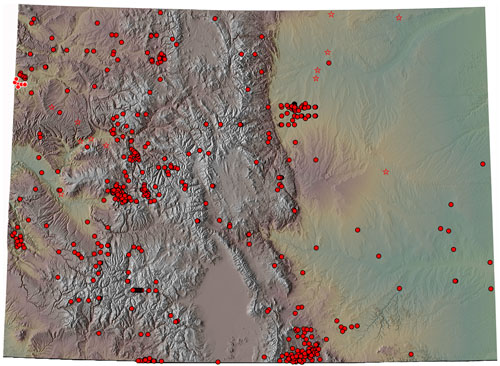Many earthquakes in Colorado occur naturally; however, they can also be caused by human actions. Humans may trigger earthquakes through different types of activities including oil and gas extraction, reservoir impoundment, fluid injection, or mining.
Although many of Colorado’s past earthquakes have occurred in mountainous regions, some have been located in the western valleys and plateau region or east of the mountains. Thousands of faults have been mapped in Colorado, but scientists think only about 90 of these have been active in the past 1.6 million years. Portions of the state have clusters of faults, such as near the Denver metro region, central mountains, and the southwestern and northwestern part of the state. Seismic activity is largely absent in Northeast Colorado.
The Sangre de Cristo Fault, which lies at the base of the Sangre de Cristo Mountains along the eastern edge of the San Luis Valley, and the Sawatch Fault, which runs along the eastern margin of the Sawatch Range, are two of the most prominent potentially active faults in Colorado. Not all of Colorado’s potentially active faults are in the mountains. For example, the Cheraw Fault, which is in the Great Plains in southeast Colorado, appears to have had movement during the recent geologic past. Some faults, such as the Derby Fault near Commerce City, cannot be seen at the earth’s surface.
Even though the seismic hazard risk in Colorado is relatively low to moderate compared to other states like California, it is likely that future damaging earthquakes will occur in Colorado. More than 500 earthquake tremors of magnitude 2.5 or higher have been recorded in the state since 1867. More earthquakes of magnitude 2.5 to 3.0 probably occurred during that time but were not recorded because of the sparse distribution of population and limited instrumental coverage in much of the state (for comparison, more than 20,500 similar-sized events have been recorded in California during the same time period.)
 The largest known earthquake in Colorado occurred on November 7, 1882, and had an estimated magnitude of 6.5. The location of this earthquake, which has been the subject of much debate and controversy over the years, appears to have been in the northern Front Range west of Fort Collins. The most economically damaging earthquake in Colorado’s history occurred on August 9, 1967, in the Denver metropolitan area. This 5.3 magnitude earthquake caused more than $1 million in damages in Denver and the northern suburbs (Colorado Natural Hazards Mitigation Plan). This earthquake is believed to have been induced by the deep injection of liquid waste into a borehole at Rocky Mountain Arsenal.
The largest known earthquake in Colorado occurred on November 7, 1882, and had an estimated magnitude of 6.5. The location of this earthquake, which has been the subject of much debate and controversy over the years, appears to have been in the northern Front Range west of Fort Collins. The most economically damaging earthquake in Colorado’s history occurred on August 9, 1967, in the Denver metropolitan area. This 5.3 magnitude earthquake caused more than $1 million in damages in Denver and the northern suburbs (Colorado Natural Hazards Mitigation Plan). This earthquake is believed to have been induced by the deep injection of liquid waste into a borehole at Rocky Mountain Arsenal.
More recently, a magnitude 5.3 earthquake occurred on August 23, 2011, causing moderate damage near Segundo and Valdez in southern Colorado. In recent years, seismic activity appears to be on an upward trend in Colorado, with 30 seismic events recorded in 2013 and 44 events recorded in 2014.
Applicable Planning Tools and Strategies
Addressing Hazards in Plans and Policies
- Comprehensive Plan
- Exploratory Scenario Planning
- Hazard Mitigation Plan
- Pre-disaster Planning
- Resilience Planning
Protecting Sensitive Areas
Improving Site Development Standards
Improving Buildings and Infrastructure
Enhancing Administration and Procedures
